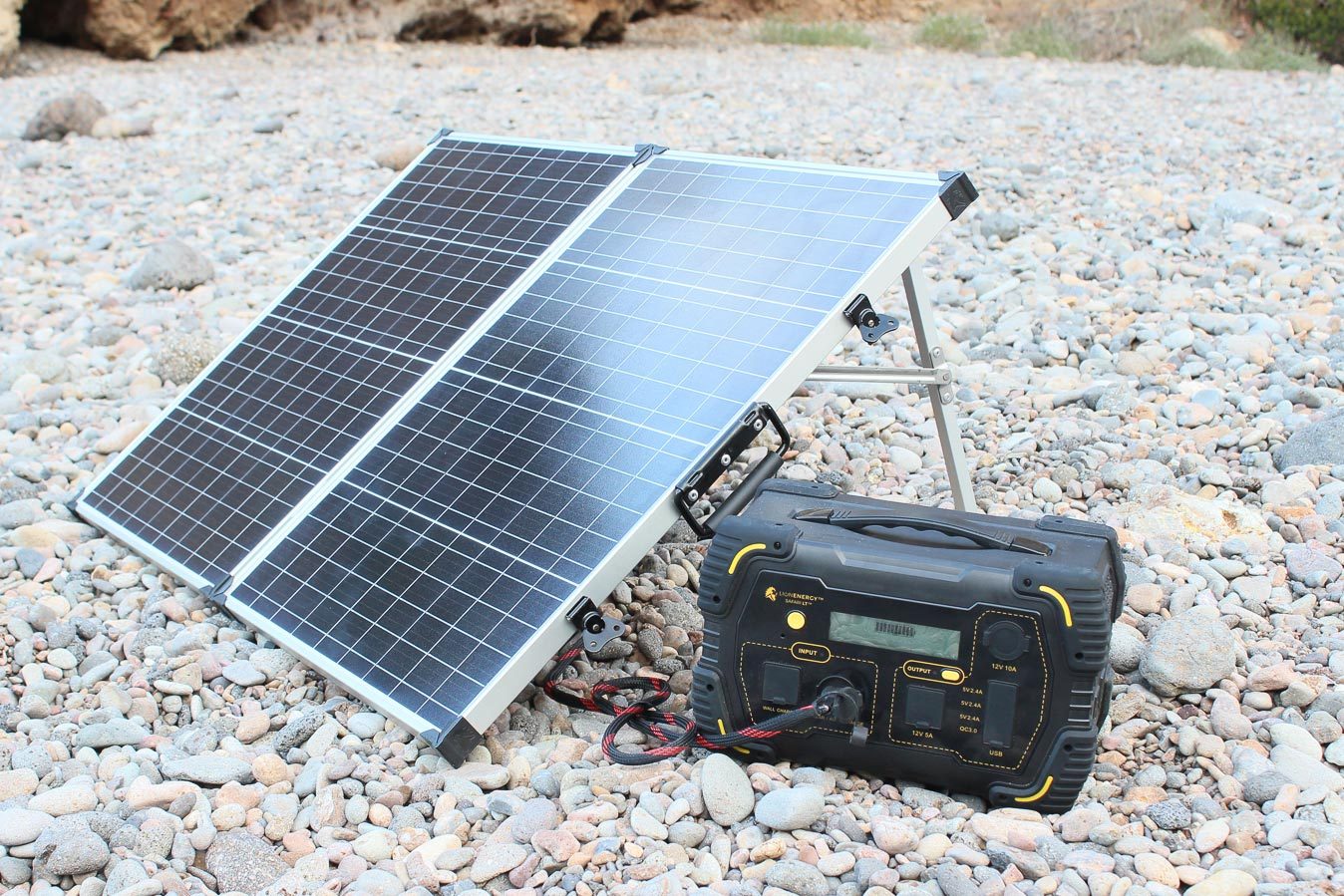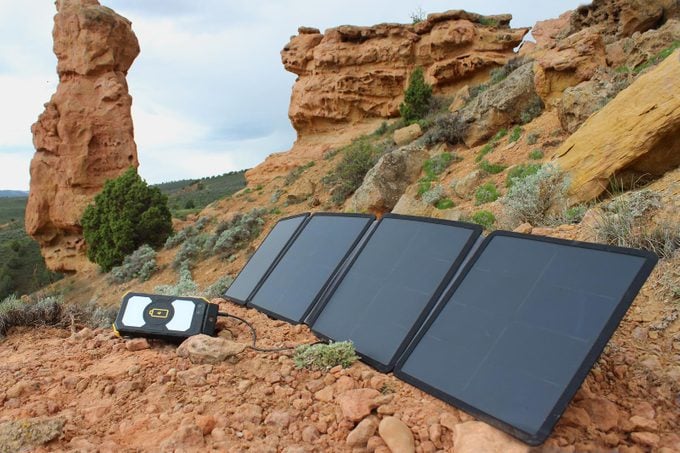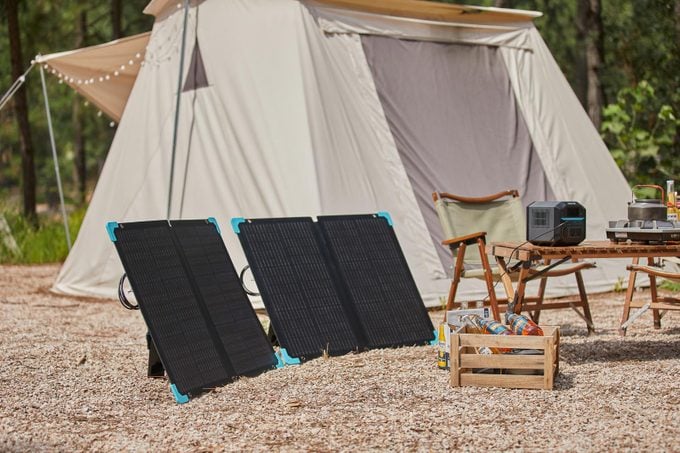Want to bring your coffeemaker camping or run your jigsaw off-grid? You can do that with a portable solar power system.

What To Know About Portable Solar Power Systems

My partner and I are on an international quest to uncover the mysteries of portable solar power systems. We’ve put them to the test on and off road, across thousands of miles from the remote deserts of Baja to the Colorado high country. And, of course, at home in the workshop.
We are now forever spoiled.
On our first outing, we used a Goal Zero Yeti 1500x power station paired with a Nomad 200-watt solar panel and two BioLite 100-watt panels. With that setup, through weeks of camping, we used the sun to run our Dometic dual-zone electric cooler, plus our coffeemaker, laptops, phones and portable shower pump.
Since then. we put a variety of brands and models to the test. Here’s what we’ve learned.
On This Page
What Is a Portable Solar Power System?
A portable power system — aka solar generator, solar power station, portable power bank or battery box — stores energy to be used at a later time. Depending on the model, it can be charged via solar panels, wind generators, a 120-volt household plug or a 12-volt car outlet.
The phrase “portable solar power systems” is a misnomer. That’s just marketing jargon for a portable power system with a solar panel charging option. Regardless of what you call them, these systems are great.
Although power stations vary in size and complexity, most include:
- A lithium-chemistry battery, because of its compact size and lightweight;
- A built-in inverter, to power household appliances and devices;
- Multiple power inputs, including Anderson connectors for solar panels, USB ports, 120V household charger plugs and sometimes 12V car charger plugs;
- A solar charge controller, to accept solar charging;
- Outputs for charging devices including USB and household plugs. Some also have 30-amp RV-style plugs.
Types of Portable Solar Power Systems

Portable solar power stations can generally be classified by capacity, battery type and inverter.
Capacity in watt hours (Wh)
Watt hours indicate how much energy a battery can store. So if a power station contains 100Wh of energy, that means it can put out 100 watts for one hour or 10 watts for 10 hours. Smartphones hold roughly 10 to 15Wh, so you could charge your phone six to 10 times with a 100Wh power station.
- Smaller portable solar power systems, like BioLite’s 80PD (74Wh) and Goal Zero’s Sherpa PD, fit into a backpack. They charge personal electronics while camping and traveling. When at home, they’re also nice to plug into when you’re feeling too lazy to move near a wall outlet to charge your phone or laptop. Often referred to as power banks, these can be charged via portable solar panels with built-in USB outlets. Most can also be charged through a wall outlet.
- Medium-sized systems, like Go Power’s DuraCube (512Wh), Lion Energy’s Summit (665Wh) and Anker’s 521 (256Wh), fit well into a car trunk for camping. They’re large enough to recharge power tool batteries on a job site or your computer. They usually include USB and Anderson connectors for use with solar panels. Most can also be charged via a wall outlet.
- Large systems, like Goal Zero’s Yeti 1500X (1,516Wh), Anker’s 757 (1,229Wh) and BioLite’s BaseCharge 1500 (1,521Wh) take up a little more room, about the size of a toaster oven. But they can run power tools, CPAP machines, coffeemakers and refrigerators.
- Extra-large systems, like Anker’s 767 (2,048Wh), Renogy’s Lycan Power Box (4,800Wh) and Goal Zero’s Yeti 6000X (6,071Wh) are clunkier to transport but better for powering RVs and campers, remote worksites or even as a home back-up system.
Batteries
Nearly all portable solar power systems use lithium battery chemistry. Currently, the two main types are LFP (or LiFePo4) and NMC (or LiNiMnCoO2). Both have their strong points, but without getting overly technical, LFP’s benefits are safety and longevity.
Though NMC is more widely used, the chemistry carries a chance of thermal runaway. Plus, LiPo4s can be charged/discharged up to 5,000 cycles on average, vs. approximately 500 cycles for NMC. However, NMC chemistry batteries are slightly lighter than LiPo4 batteries and feature higher energy densities, beneficial in certain applications.
Inverters
You’ll also need to consider the system’s inverter’s max AC watt output, which is different than watt hours.
Before purchasing, research the maximum watts of each device you want to use with it, especially with items like power tools, coffeemakers and microwaves. Make certain none of the wattage ratings exceed the inverter’s max AC watt output. If they do, the unit won’t power them.
Pros and Cons of Portable Solar Power Systems

While portable power stations have changed our camping and workshop life for the better, they come with frustrations as well. Here’s what to consider when deciding if one is right for you.
Pros
- Let you use and charge electric devices while off-grid.
- Don’t burn fossil fuels, so they’re cleaner and quieter than old-school generators.
- Can be recharged via solar panels or electrical outlets.
Cons
- Depending on recharging needs, you may need to reposition the panels throughout the day for maximum solar input.
- They can be damaged if left in extreme temperatures.
- If not disposed of properly, NMC batteries can create toxicity and thermal runaways in landfills.
How Much Do Portable Solar Power Systems Cost?
The cost varies depending on the manufacturer and included features, but plan on spending between $1 to $1.50 per watt hour.




















